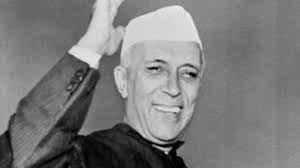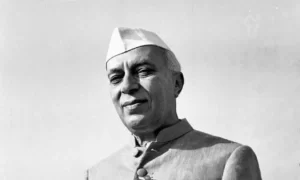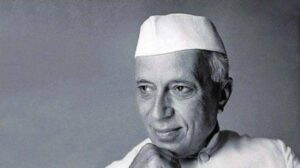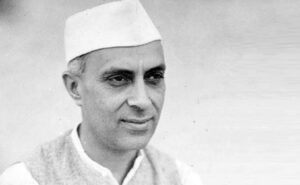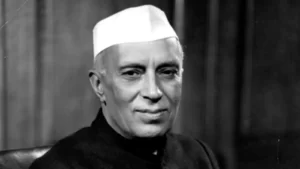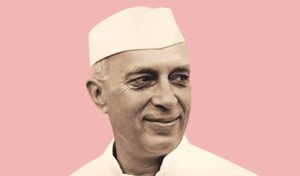Cities in our History
I stood on a mound of Mohenjodaro in the Indus Valley in the north-west of India, and all around me lay the houses and streets of this ancient city that is said to have existed over five thousand years ago; and even then it was an old and well-developed civilization.
These people of the Indus Valley had many contacts with the Sumerian civilization of that period, and there is even some evidence of an Indian colony, probably of merchants, at Akkad..
We find thus this Indus Valley civilization connected and trading with its sister civilizations of Persia, Mesopotamia, and Egypt, and superior to them in some ways. It was an urban civilization where the merchant class was wealthy and evidently played an important role. The streets, lined with stalls and what were probably small shops, give the impression of an Indian bazaar of to-day.
The Indus Valley civilization, as we find it, was highly developed and must have taken thousands of years to reach that stage. It was, surprisingly enough, a predominantly secular civilization, and the religious element, though present, did not dominate the scene. It was clearly also the precursor of later cultural periods in India.
What happened to the Indus Valley civilization and how did it end?
Some people (among them. Gordon Childe) say that there was a sudden end to it due to an unexplained catastrophe. The river Indus is well-known for its mighty floods which overwhelm and wash away cities and villages.
At Sarmath, near Benares, I would almost see the Buddha preaching his first sermon, and some of his recorded words would come like a distant echo to me through two thousand five hundred years. Ashoka’s pillars of stone with their inscriptions would speak to me in their magnificent language and tell me of a man who, though an emperor, was greater than any king or emperor.
In my own city of Allahabad or in Hardwar, I would go to the great bathing festivals, the Kumbh Mela, and see hundreds of thousands of people come, as their forebears had come for thousands of years from all over India, to bathe in the Ganges.
Astonishing thought: that any culture or civilization should have this continuity for five or six thousand years or more; and not in a static, unchanging sense, for India was changing and progressing all the time. She was coming into intimate contact with the Persians, the Egyptians, the Greeks, the Chinese, the Arabs, the Central Asians, and the people of the Mediterranean.
At Fatehpur-sikri, Akbar, forgetful of his empire, was seated holding converse and debate with the learned of all faiths, curious to learn something new and seeking an answer to the eternal problem of man.
I love to have the city beautiful, the country beautiful, the world beautiful, so that our people in future might have a glimpse of a world where they will have cooperation, a sense of service for the common good, goodwill and love for each other and not violence, hatred, exploitation and misery.
City Beautiful
Most Indian cities can be divided into two parts: the densely crowded city proper, and the widespread area with bungalows and cottages, each with a fairly extensive compound or garden, usually referred to by the English as the ‘Civil Lines’. It is in these Civil Lines that the English officials and business-men, as well as many upper middle-class Indians, professional men, officials, etc. live.
Our cities and public places are full of structures which cannot by any stretch of imagination be called artistic or pleasing to the sight. I have been shocked on many occasions at seeing these totally inadequate efforts.
All over India there is a tendency to name roads, squares and public buildings after Gandhiji. This is a very cheap form of memorial, and a certain satisfaction is gained without expense or exertion. Almost, it seems to me that this is exploiting his name, and a showing off that we honour him without any effort on our part. Even more undesirable is to change famous and historical names which have had a distinction of their own. If these tendencies are not checked we shall have thousands of roads and parks and squares named after Gandhiji. That will not contribute either to convenience or to the glory of the Father of the Nation. Only confusion will result as well as a certain drab uniformity.
When freedom comes you will see a great revival of art and beauty in this country, and I hope this will sweep away the ugliness of our homes and our cities and our lives.
The main point in building a city should be to keep the social aspect always in view. This is usually completely forgotten and people think in [terms of putting up a number of imposing official buildings. Another point to be borne in mind is that as far as possible the material to be used for construction should be locally available.
But still I should like to put before you that when I go to a great city and find great palatial buildings there, I always form my opinion of the city not from the palaces, but I form my opinion of the city from things that are happening behind these palaces-the mud-huts in which are living thousands of people, living in misery and unhappiness, missing education, sanitation, hygiene, cultural development, parks, libraries and so many other things for which the municipality is set up and so many other things.
You have large ideas; you have large visions. But you see that vested interests do come in our way whether we function as municipal commissioners or otherwise. Therefore, if I think about it, I do not envy you very much.
But after all, you are working for a great city. And I must confess that I have a love for large cities. I love the village in a way but I hate to live in villages. But I do not like the present large cities either.
Somehow, feel that the objective should be ultimately the development of the human being. Cities, after all, are moving and they will go ahead.
So I like this idea of trying to look after great cities, trying to raise their level, of making them beautiful cities, not only with beautiful buildings, but with healthy, efficient human beings, or loving people, co-operating with each other and not trying to knock each other down and exploit each other and make each other miserable. That is the ideal of the great city that I should like to have and I like to work for.
Planning Cities and Towns:
Cities that Represent: Allahabad
As it is Allahabad is quite spread out enough and scores of miles of road have to be kept in repair, watered, cleaned, lighted, etc. Schemes of Town Improvement, now being hatched in the Improve ment Trust Office, would spread out Allahabad even more and increase the burden of the Board. What is required is that the present Civil Station of Allahabad should be more built up and the compounds attached to houses should become smaller and better looked after. The income of the Board would go up and the general appearance of Allahabad would also improve. Large compounds should be penalised for this purpose, either on the basis of area or road frontage….
Allahabad is a very spread out city. Large distances separate some of the mohallas from each other and there is plenty of room for growth between these mohallas. There is considerable congestion in the city proper and in part of Katra, and on the other hand many houses in the civil station have got enormous compounds. As it is the upkeep of the roads in the civil station is a heavy burden on the municipality and it cannot afford to increase this burden by having more metalled roads without a corresponding increase in income.
Though the permanent population of Allahabad is not as large as. that of some other cities in the province, vast numbers of pilgrims visit the city and use the roads. The Grand Trunk Road in Allahabad is probably one of the most used roads in the United Provinces.
It is notorious that Allahabad is a very spread out town with great length of road. The city part is fairly congested but the Civil Station is far too sparsely populated and there are few compounds which are kept in proper condition. The Improvemes. Trust is developing schemes which will spread out Allahabad even more and burden us with the up-keep of additional miles of roads. As it is we cannot keep our roads in proper condition. How will we provide for additional roads? There is only one way and that is to discourage this spreading out and encourage the filling of the open spaces between different parts of the city..
Another noticeable feature of Allahabad is the number of open plots lying unoccupied. Plots are purchased and then houses are not built for years. So long as houses are not built no taxes can be levied. Thus the municipality has to maintain roads, light them, clean them etc. and not get anything from the owner of these areas. This is improper and it hinders growth.
Allahabad, as you are probably aware, has more pucca roads than any city in these provinces although in point of size and population several other cities are ahead of it. There are 87 miles of metalled roads here, most of these being in the civil station where there are large compounds and extensive road frontages. Owing to these large compounds the income from the houses adjoining these roads is proportionately little and the cost of keeping the roads in proper condition, in metalling, repairing, watering, lighting, and cleaning them is very great.
I suggest, therefore, that we should have in Allahabad: (i) A tax on the land values, i.c., on the selling value of the land, this being paid as long as the land is held and regardless of occupation, and it should be a charge on the land. (ii) A tax on improvements and houses, preferably at a lower rate, to be paid, as at present, when the house is occupied.
(iii) The two taxes above mentioned should not together exceed the present house tax. (iv) There should be a general assessment of land values and improvements thereon separately to enable us to determine the new taxes.
The chairman of the Town Improvement Committee is an ambitious person. He dreams of Allahabad as it should be fifty years hence. 1 envy him his dreams but not his powerlessness to realise them. To look far ahead is the only correct way of trying to improve a great city rationally and artistically. Unhappily, we have neither funds nor men to take up this work in earnest.
I think there has been a great deal of waste in the Allahabad Trust. The principal item of wasteful expenditure has been the heavy establishment charge. The whole office has been run on extravagant lines. This question has been dealt with in the Retrenchment Committee’s report in some detail. I would only mention here a few other matters. The Harcourt Butler market has been a complete failure. It had little to do with Town Improvement and the site chosen was unfortunate. Over and above the actual cost, a sum of Rs. 1,000/- or so was unjustifiably spent on the opening ceremony.
The Municipal Board had all along opposed the creation of the Trust but it is possible that, being presented with a fait accompli they might have fully cooperated with it. The early attitude of the Trust however made matters worse and the Trust began to regard the Board as a rival and inimical body. The municipal represen tatives on the Trust were considered as enemies within the camp and the unseemly spectacle of the Trust being equally divided and the Chairman voting twice was often witnessed. Owing to the opposition of the Municipal Board and the public the principal officers of the Trust were always apprehensive that their tenure of office might terminate and their time and energy was chiefly spent in consolidating their own position. Far more attention was and has been paid to their remaining in their present well paid offices than to the work of the Trust.
The problem of the upkeep of roads is intimately connected with another feature of Allahabad. Every visitor to Allahabad must notice the large compounds attached to bungalows. Most of these are not properly looked after and present a deserted appearance. It has become difficult for people here to keep farge compounds in proper condition. The obvious remedy is that large compounds should not be encouraged.
Nearly all the Big Noises and Little Noises live in the Civil Lines.
It is felt that any repairs or remetalling of these provincial roads is almost a waste of money. Very soon after the road will again be in a bad condition. Reasons of economy alone are sufficient to induce us to make these roads with more lasting material. The Board therefore suggest to Government to have all the provincial roads in the municipal area remade by the bituminous or equally good process.
I understand that Government has given help on a most generous scale to Lucknow for its roads and that in addition to a loan for the purpose a grant of five lakhs of supees had been made. I am aware that Allahabad is not to be compared with Lucknow in such matters. Nonetheless I trust that Government will be able to help this city also to some extent.
I have been shocked to see some of the roads, or rather apologies for roads, round about the city. Complaints are sometimes made about the condition of the roads in the Civil Station but few people ever hear or know about the roads in and round the city. The residents of the city are long suffering and not very vociferous. A bumble petition for the metalling of a road is met with the stock answer of no funds and when the question of road repairs and renewals is considered, it is natural to think only of the metalled roads in the Civil Station and to forget that thousands have not even a decent kutcha road leading to their houses.
The schemes on which work was begun were not happily chosen. It would have been desirable if the Trust had taken some of the congested areas in the heart of the city in hand and made small open spaces and playing grounds, and some model houses for the poor. There are plenty of suitable areas in the city where with a little expenditure considerable improvements could be made. The Trust has got lost in a number of big schemes.
I think that immediate attention should be paid to the metalling of a road leading to Atala and the road which goes to the brickkilns., Atala and Gangaganj indeed are sinks of filth and dirt. I am told that any satisfactory scheme of sanitation and drainage would require a lakh or more as the land is low and forms a kind of cup. If this scheme has to be delayed, I hope that something will be done in the immediate future to get rid of the present horror.
An important matter which should engage the attention of both the Building and the Town Improvement Committees is the construc tion of new houses on important streets like Johnstonganj. At present low and ugly and altogether disreputable structures are being built on this noble road which could have been made a sight worth seeing. I think we should have byelaws laying down definitely that only a certain style of houses will be permitted in these streets.
The problem before the Trust at present is not to improve Allahabad. The immediate issue is how to improve itself and so long as it does not do so and purge itself of its undesirable elements for so long it will not be possible for the Board or any self-respecting person to associate himself with it.
The small schemes would have been popular, and in some cases remunerative. They would also have immediately improved the sanitation and health of the locality.
In some places it is difficult to get any medical advice as no vehicles can safely go there and doctors refuse to walk the distance specially when this will involve wallowing in the mud. I think the Board has been sadly failing in its duty in its neglect of the city roads. Most of the people live in the city and by far the greatest amount of money is realised from them. And yet they derive the least advantage from it. Their money goes to improve and beautify the Civil Station. The Civil Station of Allahabad deserves to be improved and kept up to the mark, but let us not forget that its residents are getting far more than they pay for, they are taking advantage of the taxes paid by the residents of the city.
The income of the municipality from the city proper is greater than that from Civil Lines, but the expenditure on the latter far exceeds the city expenditure.
The various committees to consider matters relating to the octroi have not yet finished their labours. It is being daily impressed upon me that the present octroi rates are strangling the trade of Allahabad. It is the height of unwisdom to kill the trade of Allahabad in order to realise a little more for municipal needs. I am anxiously awaiting the reports of the committees and I hope they will tackle the problem bravely and root out the evils of the present system.
They recommended to the Improvement Trust that the area known as Minapur in Yahiapur and the land approached through Allahban de’s Phatak near Chauk might well be taken in hand for improve ment. The Trust does not view these suggestions with favour. They are too full of their own vast schemes to be able to think of smaller matters. Both Minapur and Allahbande’s Phatak are inexpensive areas which can easily be acquired and converted into garden spots with, in the latter case, some good shops or houses which would pay handsomely. Another matter which has engaged the attention of the Committee is that sink of filth and rubbish in Shahaganj known. euphemistically as the “Phool” tank.
Another matter to which the Commissioner has referred is the disposal of sullage. It is most unfortunate that after two years or so of negotiations and discussions we have returned to our starting point and have to start afresh. The question of loss of money, which we might realise immediately by the sale of the sullage, is important enough in the present state of our finances. But far more vital is the stoppage of the flow of the surplus sullage into the river near the Sangam. feel, and I am sure that members will agree with me, that it would be a crime to do any thing which might result in an epidemic amongst the vast crowds that bathe in the Sangam.
I have been repeatedly approached by the Ekkawalas of Allahabad with a list of grievances. I think their complaints are largely justified and deserve every consideration. I am informed that during the last three months or so about 1.400 prosecutions of Ekkawalas were launched by the police. This is stupendous figure and clearly indicates that something is very wrong somewhere.
Their immediate grievance, apart from the number and frequency of prosecutions, is the want of a stand in Pasarhatta near the Chauk. Some months ago, a number of Ekkas were permitted to stand in this place, but the remedy was worse than the disease and the shop keepers suffered a lot. I think that it is not desirable for us to have an Ekka stand there. We are trying our best to meet the difficulties of the Ekkawalas and hope to succeed partly at least.
No rule or byelaw which requires so many prosecutions for its enforcement can be wholly good.
Looking back over the past five or six months, I found that my outlook on municipal matters has largely changed. What I feared and disliked I have begun to like, and municipal work has begun to have some fascination for me. I feel that it is in the power of our Board to make life a little more bearable, a little less painful to the inhabitants of Allahabad. This is worthwhile work.
I regret there is no enthusiasm in Allahabad. Wherever one may go in India, one may see development, the signs of a new India being built up at a great speed. Here in Allahabad, people complain of shifting of certain offices from Allahabad to Lucknow. It is a pity we forget that in the modern age cities do not develop or prosper by offices but by industry and trade. Allahabad is a city of historic importance which made a great contribution during the last forty or fifty years of the national struggle.
Cities that represent: Bangalore
Bangalore has been a great and attractive city. There are many attractive buildings but what has attracted me most in Bangalore, have been the trees; and whenever I come here, I feast my eyes upon them. Not only here, but in Mysore city also. You have certain natural advantages and it is right that you should try to set up noble buildings.
The Corporation of Bangalore, I should imagine, is a rather proud body, proud to have this lovely city in its charge. Bangalore is very fortunately situated, and it is natural that now that India has been free for some years, Bangalore, more perhaps than any other city in India, should grow rapidly in the modern sense of the word, that is, in industry, in science and in technology. Bangalore, of course, will represent the old times also. And so it becomes that ideal combination of a city having its roots firmly grounded in the soil of our own culture and yet growing out and throwing out its branches into the modern world.
Prepare a master plan for Bangalore as it should be twenty or thirty years later. Every little thing that is built by public authority or private persons must fit in with that master plan and nobody should be allowed to spoil it. Have broad avenues and streets. In Delhi, I find that people have put up narrow streets which are totally insufficient even now. They might have been good enough in oldtimes, and it is difficult to widen the streets when you have big buildings on either side. But if you plan in advance, you can have wide avenues and streets.
You have a magnificent opportunity here in Bangalore, not only to do your primary duty of looking after the citizens and the residents. of Bangalore by giving them the amenities of civic life like healthy conditions, education, parks, libraries, and so on, but of building up in this ideal spot a beautiful city, beautiful not only to look at, but beautiful and healthy to live in.
In a city like Bangalore, rapidly growing, very particular attention has to be paid to how it grows. I see that some kind of a committee or commission has been appointed to think of the future of Greater Bangalore. I am glad at that. But I should like to know a little more of how that committee is going to function.
We have many Improvement Trusts in our big cities in India, but I confess I am not too happy with their approach to the question of the development of their cities. They may be doing good work, but they could function better.
Cities that represent: Calcutta
I do not know if you think in terms as to what Calcutta should be like twenty or thirty years hence. Do you think of what would be your problems a generation hence?
Do not limit your vision. You must think of things ahead and think of the future.
And I envy you who are in charge of the great city and who are doing a great deal of constructive work for the city. It is an enviable work.
You, as a municipality, must set an example to the vested interests that employees should be treated as human beings, that they should not be exploited. trust this corporation representing this great city will always think in terms of its large number of employees who after all, are citizens of Calcutta and will not treat them merely as persons to be exploited.
Cities that represent: Chittaranjan
Some days ago, I paid visits to the Chittaranjan Locomotive Works, the Damodar Valley, the fertilizer factory at Sindri and the Institut: of Technology at Kharagpur. This visit was very heartening and exhilarating, because I saw great new structures rising up and new townships being built, symbolic of what we want the new India to be. Sindri, which I inaugurated formally, is a very impressive affair. It is something more than a fertilizer factory. A new town has grown up where a vast chemical industry is taking shape.
In some ways the Chittaranjan Locomotive Works pleased me even more, although they are obviously on a smaller scale. Here also a new township has grown up and the town planning and the workers’ houses were very attractive. Two days later I went to Kharagpur and the workers’ houses there were very bad indeed. I visited Kanpur also and saw the slum dwellings of the workers there. I was horrified and I have not yet recovered from the shock.
Cities that represent: Kanpur
People live in these hovels under sub-human conditions and I am not surprised that the rate of tuberculosis is the highest in Cawnpore. I would say that these hovels should be burnt down immediately.
I have no need for any industrialization which degrades a human being, and sullies his honour. It would be better if the pace of industrialization slows down rather than that workers should be made to live in these shocking and humiliating conditions. It would be better if the workers had no place to live than these hovels.
Ever since I have seen the horrible hovels in Cawnpore I have developed a sort of fever. I do not mind if all the mills of Cawnpore are closed down and production goes down. But I cannot tolerate this degradation of man. Our plans will be of no use if man is to live in this sort of degrading condition.
We discuss often enough great housing schemes for workers and then we come to the conclusion that they are too costly and therefore little progress is made. It is true that the problem is colossal and unless we have the resources we cannot tackle it adequately. But I cannot reconcile myself to the continuation of these horrible slums. My immediate reaction in Kanpur was that these slums should be burnt. That reaction holds still and I am. convinced that it is better to have no houses at all and for the workers to be given an open space to live in temporarily than to be made to live in places which are not fit for domestic animals.
Cities that represent: Pondicherry
I look upon Pondicherry with its background of French culture and language as something that enriches Indian culture. It is something that I should like to preserve. French is one of the great languages of the world; it is a very beautiful language, and we should welcome it. I should like Pondicherry to continue to be the seat of the French language. It can serve India in that manner.
I need not say much more to you except that the-justification of what will happen in future will depend on how we serve the common man of Pondicherry. The future of Pondicherry might depend to some extent on us sitting in Delhi or our officers here, but it will depend far more on the people of Pondicherry, on you gentlemen, and others here, and on how far you can co-operate together for the common good.
Cities that represent: Shimla
Of my various engagements during these two eventful weeks in Simla, not the least in importance was my visit to the scavengers’ quarters in the city. A city is not judged by its palaces and braod avenues. A truer measure is the condition of its humbler citizens, their houses and quarters, and there standard of living.
Scavengers, who perform the most essential tasks in our society, have by a perverse fate and an unjust social order, been placed at the bottom of the social scale. It is up to us to change this completely by raising them and bettering their conditions.
I was shocked to see the quarters of the scavengers. The situation was bad, the tiny rooms were dark and damp and often I could not make out how so many people could possibly live in such at restricted space. In a little room of about ten feet by eight there was a family of ten. Cooking, bathing etc., have all to take place inside this room or cell. The contrast between this and the noble mansions and gardens of the prosperous classes in Simla is startling, and most painful to contemplate.
The Simla Municipality, as being especially responsible for this state of affairs, ought to be ashamed. But all of us who live in palaces and mansions of Simla must share that shame. I hope the municipality and the citizens of Simla will endeavour to put an end to this iniquity.


